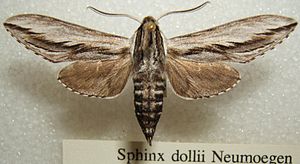Sphinx dollii
| Sphinx dollii | ||||||||||||
|---|---|---|---|---|---|---|---|---|---|---|---|---|

Sphinx dollii (preparation) |
||||||||||||
| Systematics | ||||||||||||
|
||||||||||||
| Scientific name | ||||||||||||
| Sphinx dollii | ||||||||||||
| Neumoegen , 1881 |
Sphinx dollii is a butterfly ( moth ) from the family of moth (Sphingidae). The species inhabits parts of the southwest and western United States .
features
The moths have a fore wing length of only 22 to 29 millimeters, making them the smallest species of the genus Sphinx . The size alone distinguishes the species from all other species in the genus with the exception of Sphinx sequoiae . Most often the forewings are gray on top with a brown cast. In the case of the similar species, this is instead bluish. The similar species is also less patterned on the forewings. A black line runs diagonally across the wings from the base to the wing tip, which is interrupted and less developed in the similar species. In Sphinx dollii, two pairs of longitudinal lines run along the thorax , which often merge into a broad, dark band. In the similar species, only a fine pair of black lines is formed. The type is variable. In the north, for example in Colorado, the forewings of the moths are clearly patterned. The subterminal line is easy to see and the area from it to the base is almost white. In Arizona, the moths are less patterned on the forewings and the subterminal line is also clearly reduced. The white in the basal area is also weak. In the mountains of New Mexico and southern Arizona, the fore wings of the animals are almost solid blue-gray and the subterminal line is almost invisible.
The caterpillars look similar to those of Sphinx sequoiae . They have a strong green base color and are provided with a series of white dots on each body segment. As a result, they are perfectly camouflaged on the young shoots of the food plants. In contrast to the similar species, the brown spots on the back are absent in at least some individuals and the row of brown spots below the spiracles has receded considerably.
The pupa is the only species of the genus that has a completely overgrown trunk sheath. Their color also differs significantly from the other species. It is black and has two pairs of broad, wine-red longitudinal stripes that run along the abdomen above and below the spiracles. These features make the doll unmistakable.
Occurrence
The species is distributed from the southwestern United States north over the Rocky Mountains to the extreme southeast of Idaho. It has also been identified from the hill country of Central Texas and the Texas Panhandle . Evidence exists from eastern San Bernardino County in California, along the Nevada-Arizona border.
Sphinx dollii is commonly found locally in the intermediate elevations of the juniper and pine zones in the southwestern United States and in the foothills of the Rocky Mountains.
Way of life
The way of life of the species has hardly been researched. The moths often fly to light sources.
Flight and caterpillar times
The moths fly in the north from early June, in the south from mid-July to early August, presumably in one generation.
Food of the caterpillars
The caterpillars have so far only been found on alligator juniper ( Juniperus deppeana ), but due to their distribution it has been shown that other juniper species that have not yet been documented as food plants must be eaten.
development
How the females lay their eggs is unknown, although it is certain that they are laid one by one. The development of three caterpillars raised in captivity was very slow. The animals required at least two weeks for the last two stages. The pupation is only documented from the rearing of these three animals. The caterpillar digs a chamber just below the surface of the earth to pupate.
supporting documents
Individual evidence
- ↑ a b c d e f g h i James P. Tuttle: The Hawkmoths of North America, A Natural History Study of the Sphingidae of the United States and Canada. The Wedge Entomological Research Foundation, Washington, DC 2007, ISBN 978-0-9796633-0-7 .
literature
- James P. Tuttle: The Hawkmoths of North America, A Natural History Study of the Sphingidae of the United States and Canada. The Wedge Entomological Research Foundation, Washington, DC 2007, ISBN 978-0-9796633-0-7 .